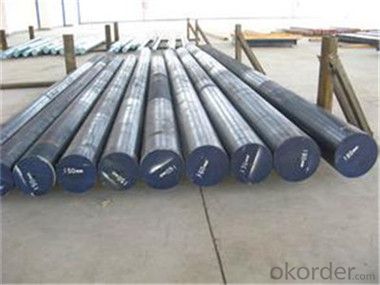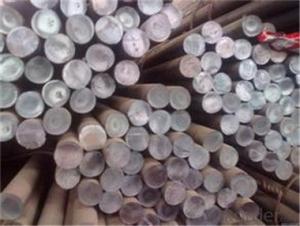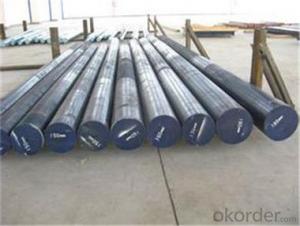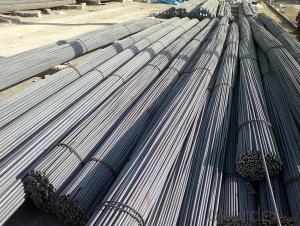Steel Round Bar Reliable Manufacturer with High Quality
- Loading Port:
- Tianjin
- Payment Terms:
- TT OR LC
- Min Order Qty:
- 55 m.t.
- Supply Capability:
- 2000000 m.t./month
OKorder Service Pledge
OKorder Financial Service
You Might Also Like
Description of steel round bar:
1.Diameter 80 to 800 mm
2.Black or Bright surface
3.Annealed or Quenched and tempered provided
4.Cutting service provide
This steel has good workability,processing deformation is small, anti fatigue performance is quite good, belongs to medium quenching steel,4140 after heat treatment, it has good strength and good comprehensive mechanical properties.The process is good.
Festures of steel round bar:
4340 Forged Round Steel Bar
1.Dia 80-800mm Length:2000-13000mm or as required
2.Technique:Forged
3.Delivery Time:45 days
Specifications of steel round bar:
1. Standards: AISI 4340 8620 8640 4320 , JIS SNCM8 GB:40CrNiMoA
2. Specification: Dia: 80~450mm Length:2000-13000mm or as required
3. Process: EAF+LF+VD ( necessary) UT+ Peeled +Turned + Heat Treatment (optional)
Images of coffee machine:

FAQ:
1. What is your package?
Packing situation: standard seaworthy packing or as customer required.
2. How long is the lead time?
Delivery time: 45 days after order confirmed.
3. What payment term do you accept?
Payment: T/T or L/C at sight.
- Q:Can steel round bars be used in the power generation industry?
- Indeed, the power generation industry does make use of steel round bars. These bars, known for their immense strength and durability, are frequently employed in the construction of power generation equipment and infrastructure. They are particularly valuable in the fabrication of turbine shafts, generator rotors, gears, and other components that require the ability to withstand heavy loads and resist wear and fatigue. Moreover, steel round bars can be readily machined and welded, thereby rendering them a highly versatile material for a wide range of applications in the power generation sector.
- Q:Can steel round bars be used for making agricultural equipment?
- Yes, steel round bars can be used for making agricultural equipment. Steel is a strong and durable material that can withstand heavy use and provide the necessary strength and stability required for agricultural equipment.
- Q:What are the different cutting methods for steel round bars?
- Depending on the specific requirements and available equipment, there are various cutting methods that can be used for steel round bars. Here are some of the most commonly used ones: 1. Sawing: Sawing is a traditional and basic method of cutting steel round bars. It involves using a saw blade with teeth to cut through the metal. This can be done manually with a hacksaw or with the assistance of a bandsaw or circular saw. Sawing is a versatile method suitable for both small and large-scale cutting projects. 2. Shearing: Another commonly used method is shearing. It utilizes a shear machine or hydraulic press to apply high force and cut through the metal. Shearing is particularly effective for cutting thick or heavy-duty steel bars. 3. Abrasive cutting: For steel round bars with irregular shapes or precision cutting projects, abrasive cutting is often employed. This method involves using an abrasive wheel or disc to grind away the metal and create the desired cut. It can be performed manually with a handheld grinder or with the assistance of an abrasive cut-off saw. 4. Flame cutting: Also known as oxy-fuel cutting, flame cutting employs a combination of oxygen and a fuel gas to create a high-temperature flame that melts and cuts through the steel. This method is commonly used for cutting thick steel bars or shaping metal. 5. Plasma cutting: Plasma cutting is an advanced method that utilizes a plasma torch to cut through the steel. The torch generates a high-velocity jet of ionized gas, which melts and removes the metal. Plasma cutting is often preferred for precision cutting due to its greater control and ability to produce cleaner cuts compared to other methods. It is important to consider factors such as the thickness and hardness of the steel round bar, desired precision of the cut, and available equipment when selecting a cutting method. Consulting with a professional or experienced metalworker is recommended to determine the most suitable method for a specific project.
- Q:What are the different treatments available for steel round bars?
- There are several different treatments available for steel round bars, depending on the desired properties and applications. Some common treatments include: 1. Heat Treatment: This process involves heating the steel round bars to a specific temperature and then cooling it rapidly or slowly to alter its mechanical properties. Heat treatment can improve hardness, strength, toughness, and resistance to wear and corrosion. 2. Quenching and Tempering: Quenching involves rapidly cooling the heated steel round bars in a liquid medium, such as water or oil, to increase hardness. Tempering follows quenching and involves reheating the steel to a lower temperature to reduce brittleness and increase toughness. 3. Surface Hardening: This treatment is used to increase the hardness of the outer layer of the steel round bar while maintaining a tough and ductile core. Common surface hardening methods include carburizing, nitriding, and induction hardening. 4. Cold Working: Cold working involves deforming the steel at room temperature through processes like rolling, drawing, or extrusion. This treatment can increase the strength and hardness of the steel round bars, while also improving dimensional accuracy and surface finish. 5. Coating: Applying a protective coating to steel round bars can enhance their resistance to corrosion and wear. Common coatings include zinc plating, galvanizing, and various types of paint or epoxy coatings. 6. Shot Blasting: This treatment involves shooting small metallic or abrasive particles at high speeds onto the surface of the steel round bars. Shot blasting can remove contaminants, scale, and rust, resulting in a clean and polished surface. It's important to note that the choice of treatment depends on the specific requirements of the steel round bars and the intended application. Consulting with experts or metallurgists is recommended to determine the most suitable treatment for a particular situation.
- Q:What are the environmental considerations of steel round bars?
- Steel round bars have several environmental considerations. Firstly, the production of steel requires a significant amount of energy, which often comes from non-renewable sources, leading to greenhouse gas emissions and contributing to climate change. Additionally, the extraction and processing of raw materials for steel production, such as iron ore and coal, can have detrimental effects on local ecosystems and habitats. Furthermore, the transportation of steel round bars can result in carbon emissions if not done efficiently. However, steel is a highly recyclable material, and the use of recycled steel in the production of round bars can help reduce environmental impact. Additionally, the durability and strength of steel make it a long-lasting material, leading to less waste in the long run.
- Q:What are the advantages of using nickel-chromium-aluminum alloy steel round bars?
- Nickel-chromium-aluminum alloy steel round bars offer numerous benefits. Firstly, they possess exceptional corrosion resistance, making them ideal for use in harsh environments or industries where corrosion is a concern. This resistance to corrosion prolongs the lifespan of the round bars, reducing maintenance and replacement expenses. Secondly, these round bars are known for their high strength and durability, making them suitable for applications that involve heavy loads or high temperatures. Their strength also enhances structural stability, making them a dependable option for construction projects and industrial applications. Additionally, this alloy steel demonstrates excellent thermal stability, allowing it to maintain its shape and mechanical properties even under elevated temperatures. This attribute is particularly advantageous in industries such as aerospace, automotive, and power generation, where high temperatures are prevalent. Furthermore, nickel-chromium-aluminum alloy steel round bars offer good formability and machinability, facilitating easy fabrication and customization. This versatility allows for the production of intricate shapes and designs, making them adaptable for various manufacturing processes. Lastly, this alloy steel is recognized for its resistance to oxidation and scaling at high temperatures. This makes it suitable for applications involving exposure to extreme heat or rapid temperature changes, such as in furnaces or heat exchangers. In conclusion, the benefits of utilizing nickel-chromium-aluminum alloy steel round bars include exceptional corrosion resistance, high strength and durability, thermal stability, formability, and resistance to oxidation. These qualities make it a preferred choice for a wide range of industries, ensuring reliable performance and longevity in various applications.
- Q:Can steel round bars be used for construction purposes?
- Indeed, construction purposes can make use of steel round bars. Several applications in construction commonly utilize steel round bars, including reinforcement in concrete structures, support for beams and columns, and as structural components in bridges, buildings, and infrastructure projects. The exceptional tensile strength and durability of steel render it a perfect option for construction purposes, capable of withstanding heavy loads, providing stability, and ensuring the longevity and safety of structures. Furthermore, steel round bars offer versatility, as they can be easily fabricated and customized to meet specific project requirements. Hence, due to their excellent mechanical properties, reliability, and cost-effectiveness, steel round bars find extensive use in the construction industry.
- Q:Are steel round bars susceptible to cracking?
- Cracking in steel round bars can occur under certain circumstances. Factors that contribute to cracking include high stress levels, improper heat treatment, and the presence of impurities or defects in the material. Cracking is also more likely with sudden temperature changes or excessive loading. It is worth noting that the susceptibility to cracking varies depending on the grade and composition of the steel. Low carbon or mild steel is generally less prone to cracking compared to higher carbon or alloy steels. To prevent cracking, it is crucial to handle and store steel round bars properly. This includes avoiding dropping or mishandling the bars and storing them in a dry, controlled environment to prevent corrosion. Proper heat treatment processes, such as annealing or tempering, can improve the structural integrity of steel round bars and reduce the risk of cracking. Regular inspections and testing for defects or impurities can help identify and address issues before they lead to cracking. In conclusion, while steel round bars can be susceptible to cracking, taking appropriate precautions and using proper manufacturing and handling techniques can minimize the risk and ensure the bars' integrity.
- Q:Can steel round bars be used for making wheel hubs?
- Indeed, wheel hubs can be crafted using steel round bars. The preference for steel round bars in the fabrication of wheel hubs is attributed to their robustness and longevity. The cylindrical form of these bars facilitates effortless machining and shaping to meet the desired wheel hub design. Steel is renowned for its remarkable tensile strength and ability to withstand deterioration, making it an optimal substance for wheel hubs that must endure substantial loads and incessant wheel rotation. Moreover, steel is easily accessible and comparatively economical in contrast to alternative materials, rendering it a favored selection in the automotive sector for wheel hub manufacturing.
- Q:How can I connect channel steel and round steel?
- First, the channel steel, channel cut, need to connect the length of the arc shaped gap, and then again and round steel arc surface welding, welding before the two kinds of materials to rust, and full welding.
1. Manufacturer Overview |
|
|---|---|
| Location | |
| Year Established | |
| Annual Output Value | |
| Main Markets | |
| Company Certifications | |
2. Manufacturer Certificates |
|
|---|---|
| a) Certification Name | |
| Range | |
| Reference | |
| Validity Period | |
3. Manufacturer Capability |
|
|---|---|
| a)Trade Capacity | |
| Nearest Port | |
| Export Percentage | |
| No.of Employees in Trade Department | |
| Language Spoken: | |
| b)Factory Information | |
| Factory Size: | |
| No. of Production Lines | |
| Contract Manufacturing | |
| Product Price Range | |
Send your message to us
Steel Round Bar Reliable Manufacturer with High Quality
- Loading Port:
- Tianjin
- Payment Terms:
- TT OR LC
- Min Order Qty:
- 55 m.t.
- Supply Capability:
- 2000000 m.t./month
OKorder Service Pledge
OKorder Financial Service
Similar products
New products
Hot products
Related keywords































